Whitechapel
Whitechapel is a district[2] in East London and the future administrative centre of the London Borough of Tower Hamlets. It is a part of the East End of London, 3.4 miles (5.5 km) east of Charing Cross. It was part of the ancient parish of Stepney, Middlesex. It was split off as a separate parish in the 14th century. It became part of the County of London in 1889 and Greater London in 1965. Because the area is close to the London Docklands and east of the City of London, it has been a popular place for immigrants and the working class.
| Whitechapel | |
|---|---|
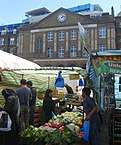 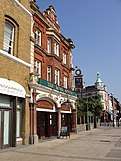 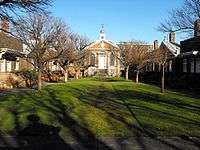   Top from left: Royal London Hospital and Whitechapel Market; Blind Beggar pub. Middle from left: East London Mosque; Trinity Green and Alms Houses. Bottom from left: Altab Ali Park; Redmans Road; | |
 Whitechapel Location within Greater London | |
| Population | 14,862 (Whitechapel ward 2011)[1] |
| OS grid reference | TQ335815 |
| London borough | |
| Ceremonial county | Greater London |
| Region | |
| Country | England |
| Sovereign state | United Kingdom |
| Post town | LONDON |
| Postcode district | E1 |
| Dialling code | 020 |
| Police | Metropolitan |
| Fire | London |
| Ambulance | London |
| UK Parliament | |
| London Assembly | |
The area was the centre of the London Jewish community in the 19th and early 20th century, and the location of the infamous 11 Whitechapel murders (1888–91), some of which were attributed to the mysterious serial killer known as Jack the Ripper. In the latter half of the 20th century, Whitechapel became a significant settlement for the British Bangladeshi community, and has the Royal London Hospital and East London Mosque.
History
Before the 19th century
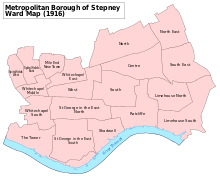
Whitechapel's heart is Whitechapel High Street, extending further east as Whitechapel Road, named after a small chapel of ease dedicated to St Mary. The church's earliest known rector was Hugh de Fulbourne in 1329. Around 1338, it became the parish church of Whitechapel, called, for unknown reasons, St Mary Matfelon. The church was severely damaged during the Blitz and demolished in 1952, and its location and graveyard is now a public garden on the south side of the road.[3][4]
Whitechapel High Street and Whitechapel Road are now part of the A11 road, anciently the initial part of the Roman road between the City of London and Colchester, exiting the city at Aldgate.[5] In later times, travellers to and from London on this route were accommodated at the many coaching inns which lined Whitechapel High Street.[3]
By the late 16th century, the suburb of Whitechapel and the surrounding area had started becoming 'the other half' of London. Located east of Aldgate, outside the City Walls and beyond official controls, it attracted the less fragrant activities of the city, particularly tanneries, breweries, foundries (including the Whitechapel Bell Foundry, which later cast Philadelphia's Liberty Bell and London's Big Ben) and slaughterhouses.
In 1680, the Rector of Whitechapel, Ralph Davenant, of the parish of St Mary Matfelon, bequeathed a legacy for the education of forty boys and thirty girls of the parish; the Davenant Centre is still in existence although the Davenant Foundation School moved from Whitechapel to Loughton in 1966.
Population shifts from rural areas to London from the 17th century to the mid-19th century resulted in great numbers of more or less destitute people taking up residence amidst the industries and mercantile interests that had attracted them.
In 1797, the body of the sailor Richard Parker, hanged for his leading role in the Nore mutiny, was given a Christian burial at Whitechapel after his wife exhumed it from the unconsecrated burial ground to which it was originally consigned. Crowds gathered to see the body before it was buried.
19th century
By the 1840s, Whitechapel, along with the enclaves of Wapping, Aldgate, Bethnal Green, Mile End, Limehouse, Bow, Bromley-by-Bow, Poplar, Shadwell and Stepney (collectively known today as "the East End"), had evolved into classic "Dickensian" London, with problems of poverty and overcrowding. Whitechapel Road itself was not particularly squalid through most of this period; it was the warrens of small dark streets branching from it that contained the greatest suffering, filth and danger, such as Dorset Street (now a private alley but once described as "the worst street in London"[6]), Thrawl Street, Berners Street (renamed Henriques Street), Wentworth Street, and others.
William Booth began his Christian Revival Society, preaching the gospel in a tent, erected in the Friends Burial Ground, Thomas Street, Whitechapel, in 1865. Others joined his Christian Mission, and on 7 August 1878 the Salvation Army was formed at a meeting held at 272 Whitechapel Road.[7] A statue commemorates both his mission and his work in helping the poor.[8]
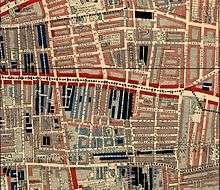
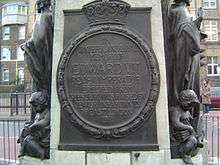
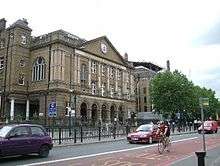
In the Victorian era the basal population of poor English country stock was swelled by immigrants from all over, particularly Irish and Jewish. Writing of the period 1883–1884, Yiddish theatre actor Jacob Adler wrote, "The further we penetrated into this Whitechapel, the more our hearts sank. Was this London? Never in Russia, never later in the worst slums of New York, were we to see such poverty as in the London of the 1880s."[9]
This endemic poverty drove many women to prostitution. In October 1888 the Metropolitan Police estimated that there were 1,200 prostitutes "of very low class" resident in Whitechapel and about 62 brothels.[10] Reference is specifically made to them in Charles Booth's Life and Labour of the People in London, specially to dwellings called Blackwall Buildings belonging to Blackwall Railway. Such prostitutes were numbered amongst the 11 Whitechapel murders (1888–91), some of which were committed by the legendary serial killer known as 'Jack the Ripper'. These attacks caused widespread terror in the district and throughout the country and drew the attention of social reformers to the squalor and vice of the area, even though these crimes remain unsolved today.[11]
The "Elephant Man" Joseph Merrick (1862–1890) became well known in Whitechapel — he was exhibited in a shop on the Whitechapel Road before being helped by Frederick Treves (1853–1923) at the Royal London Hospital, opposite the actual shop. There is a museum in the hospital about his life.[12]
20th century
In 1902, American author Jack London, looking to write a counterpart to Jacob Riis's seminal book How the Other Half Lives, donned ragged clothes and boarded in Whitechapel, detailing his experiences in The People of the Abyss. Riis had recently documented the astoundingly bad conditions in large swaths of the leading city of the United States.
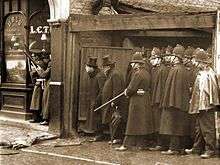
The Siege of Sidney Street in January 1911 was a gunfight between police and military forces and Latvian revolutionaries. Then Home Secretary Winston Churchill took over the operation where his presence caused a political row over the level of his involvement during the time. His biographers disagreed and said he gave no operational commands to the police,[13][14] but a Metropolitan Police account states that the events of Sidney Street were "a very rare case of a Home Secretary taking police operational command decisions".[lower-alpha 1]
The Freedom Press, a socialist publishing house, thought it worthwhile to explore conditions in the leading city of the nation that had invented modern capitalism. He concluded that English poverty was far rougher than the American variety. The juxtaposition of the poverty, homelessness, exploitive work conditions, prostitution, and infant mortality of Whitechapel and other East End locales with some of the greatest personal wealth the world has ever seen made it a focal point for leftist reformers and revolutionaries of all kinds, from George Bernard Shaw, whose Fabian Society met regularly in Whitechapel, to Vladimir Lenin, led rallies in Whitechapel during his exile from Russia.[16] The area is still home to Freedom Press, the anarchist publishing house founded by Charlotte Wilson.
In Sunday 4 October 1936, the British Union of Fascists led by Oswald Mosley clashed in the East End including a part of southern Whitechapel on Cable Street with various anti-fascist demonstrators, including local Jewish, Irish, socialist, anarchist and communist groups during the Battle of Cable Street where Mosley planned to send thousands of marchers dressed in uniforms styled on those of Blackshirts through the East End, which then had a large Jewish population.[17]
Whitechapel remained poor (and colourful) through the first half of the 20th century, though somewhat less desperately so. It suffered great damage in the Blitz and from the German V-weapon attacks of World War II. Since then, Whitechapel has lost most of its notoriety.
Altab Ali was murdered by three teenagers on 4 May 1978 in a racist attack at St Mary's Gardens by St Mary's Churchyard as he walked home after work. The reaction to his murder provoked the mass mobilisation of the Bengali community locally and came to represent the self-organisation of the community. The gardens of the churchyard were later renamed Altab Ali Park in his memory.
21st century
The Metropolitan line between Hammersmith and Whitechapel was withdrawn in 1990 and shown separately as a new line called the Hammersmith & City line.[18][19]
Crossrail will call at Whitechapel station[20] on the Elizabeth line. Eastbound services will be split into two branches after leaving the station which is undergoing a massive redevelopment of the historic station that started in 2010.[21]
In order to prepare for Crossrail, in January 2016, the old Whitechapel Station was closed for refurbishment and modernisation work in order to improve services and increase capacity in the station.[22]
The Royal London Hospital was closed and re-opened behind the original site in 2012 in a brand new building costing £650m.[23] The old site was then repurchased by the local council to open a new town hall,[24] replacing the existing Town Hall at Mulberry Place.
Governance
Local council facilities will be grouped within the old Royal London Hospital building as a civic center. The local library, now called an Idea Store is located on Whitechapel Road.
Culture
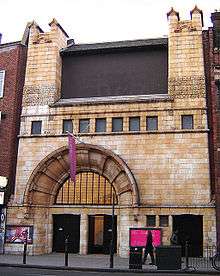
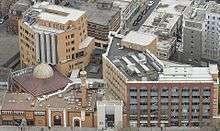
Whitechapel Road was the location of two 19th-century theatres: The Effingham (1834–1897) and The Pavilion Theatre (1828–1935; building demolished in 1962). Charles Dickens, Jr. (eldest child of Charles Dickens), in his 1879 book Dickens's Dictionary of London, described the Pavilion this way: "A large East-end theatre capable of holding considerably over 3,000 persons. Melodrama of a rough type, farce, pantomime, &c."[26] In the early 20th century it became the home of Yiddish theatre, catering to the large Jewish population of the area, and gave birth to the Anglo-Jewish 'Whitechapel Boys' avant-garde literary and artistic movement.
Since at least the 1970s, Whitechapel and other nearby parts of East London have figured prominently in London's art scene. Probably the area's most prominent art venue is the Whitechapel Art Gallery, founded in 1901 and long an outpost of high culture in a poor neighbourhood. As the neighbourhood has gentrified, it has gained citywide, and even international, visibility and support. From 2005 the gallery underwent a major expansion, with the support of £3.26 million from the Heritage Lottery Fund. The expanded facility opened in 2009.
Whitechapel in the early 21st century has figured prominently in London's punk rock/skuzz rock scene, with the main focal point for this scene being Whitechapel Factory and Rhythm Factory bar/restaurant/nightclub. This scene includes the likes of The Libertines, Zap!, Nova, The Others, Razorlight, and The Rakes, all of whom have had some commercial success in the music charts.
Home to centres such as London Action Resource Centre and rampART, Whitechapel is seen by many as a cultural hub for community based political activism particularly of an anti-authoritarian, anti-war trend. The anarchist publishing house Freedom Press is nearby in Aldgate and one of the London chapters of Food Not Bombs serves regular meals in Altab Ali Park on Whitechapel High Street. Whitechapel Anarchist Group has also recently been formed and circulates a local freesheet called W.A.G. (Whitechapel Anarchist Group)
In the past Whitechapel has been home to such individuals as Rudolf Rocker (1873–1958), anarcho-syndicalist writer, historian and prominent activist who active in the area from 1895 to 1918. Charles Lahr (1885–1971), anarchist bookseller/publisher and secretary of Whitechapel branch of the Industrial Union of Direct Actionists (IUDA), was also a prominent figure resident in the area. Such individuals in history have helped form the culture of enthusiasm in political alternatives that is enjoyed in the community today.
Demographics
The Bangladeshis are the most visible migrant group today, who make up 40% of the Whitechapel ward total population.[27] The East London Mosque at the end of Whitechapel Road is a major symbol of the resident Islamic community. The mosque group was established as early as 1910, and the demand for a mosque grew as the Sylheti community grew rapidly over the years.
In 1985 this large, purpose built mosque with a dome and minaret was built in the heart of Whitechapel, attracting thousands of worshippers every week, and it was further expanded with the London Muslim Centre in 2004.[28] The Altab Ali Park near Adler Street was formerly a church site but was destroyed during the Blitz. It was renamed to 'Altab Ali Park' in memory of a Bangladeshi clothing worker who was the victim of a racially motivated murder on 4 May 1978, and of other victims of racist attacks during the 1970s.[29][30]
A library, the Whitechapel Idea Store, constructed in 2005 at a cost of £12 million by William Verry to a design by David Adjaye, was nominated for the 2006 Stirling Prize.[31][32]
| Whitechapel compared 2011 | White British | Asian | Black |
|---|---|---|---|
| Whitechapel Population 14,862 | 24.4% | 49.8% | 4.4% |
| London Borough of Tower Hamlets | 31.2% | 41.2% | 7.3% |
In literature
Whitechapel features in Charles Dickens's Pickwick Papers (chapter 22) as the location of the Bull Inn, where the Pickwickians take a coach to Ipswich. En route, driving along Whitechapel Road, Sam Weller opines that it is "not a wery nice neighbourhood" and notes the correlation between poverty and the abundance of oyster stalls here.[33] One of Fagin's dens in Dickens's Oliver Twist was located in Whitechapel and Fagin, himself, was possibly based on a notorious local 'fence' named Ikey Solomon (1785–1850).
Whitechapel is also the setting of several novels by Jewish authors such as Children of the Ghetto and The King of Schnorrers by Israel Zangwill and Jew Boy by Simon Blumenfeld. Several chapters of Sholem Aleichem's classic Yiddish novel Adventures of Mottel the Cantor's Son take place in early 20th-century Whitechapel, depicted from the point of view of an impoverished East European Jewish family fleeing the pogroms. The novel Journey Through a Small Planet by Emanuel Litvinoff vividly describes Whitechapel and its Jewish inhabitants in the 1920s and 1930s.
The prostitute and daughter of a Luddite leader Sybil Gerard, main character of William Gibson and Bruce Sterling's novel The Difference Engine comes from Whitechapel. The novel's plot begins there.
Brick Lane, the 2003 novel by Monica Ali is based in Whitechapel and documents the life of a young Bangladeshi woman's experience of living in Tower Hamlets in the 1990s and early 2000s.
Whitechapel is used as a location in most Jack the Ripper fiction. One such example is the bizarre White Chappel Scarlet Tracings (1987) by Iain Sinclair.[34] It also features as the setting for the science fiction Webcomic FreakAngels, written by popular comics writer Warren Ellis.
In 2002, Whitechapel was used as the setting for a Sherlock Holmes film, The Case of the Whitechapel Vampire, based on the Arthur Conan Doyle story The Adventure of the Sussex Vampire.
Whitechapel serves as the setting for the television series Ripper Street, which aired 2013–2016.
Education
Transport
History
The East London line extension northwards to Highbury & Islington and southwards to West Croydon was completed in 2010. A further extension opened in 2012 to provide a complete rail ring route around south London to Clapham Junction. Whitechapel is also scheduled to be a stop on the Crossrail project, for which preparatory works began in September 2010[35] at a large site excavating 'Cambridge Heath Shaft' (located at the eastern end of the Crossrail platform tunnels and adjacent to the junction of Whitechapel Road and Cambridge Heath Road, with Sainsbury's superstore and car park to the north-west of the site and The Blind Beggar public house immediately to the west).[36] This is now likely to be completed in 2018.[37]
Current
Whitechapel is the main station in the district which is on the London Underground Hammersmith & City and District lines east–west and also the East London Line and connecting South London Line services north–south (re-opened as London Overground on June 2010)[38]
The Docklands Light Railway (Bank/Tower Gateway branch) and London, Tilbury and Southend Railway passes through Whitechapel to the south but there are presently no stations.
London Buses 15, 25, 106, 115, 135, 205, 254, D3, N15, N205, N253, N550 and N551 all operate within the area.
Whitechapel is connected to the National Road Network by both the A11 on Whitechapel Road in the centre and to the south the A13 and The Highway A1203 running east–west.
Cycle Superhighway CS2 runs from Aldgate to Stratford on the A11.
Nearest places
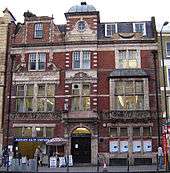
- Districts
Notable natives or residents
In addition to the prominent figures detailed in the article:
Born in Whitechapel
- Damon Albarn – musician, lead singer of Blur and co-creator of virtual cartoon rock band Gorillaz, born 1968[39]
- Julius Stafford Baker, cartoonist[40]
- Abraham Beame, first Jewish mayor of New York City, 1906–2001
- Jack Kid Berg, boxer, "The Whitechapel Windmill", British Lightweight Champion 1934
- Stanley Black, bandleader, 1913–2002.
- Simon Blumenfeld, novelist, playwright and columnist, 1907–2005.
- Georgia Brown (born Lillian Klot), actress and singer, 1933–1992.
- Tina Charles, 1970s disco artist, born 1954
- Peter Cheyney, mystery writer and journalist, 1896–1951
- Jack Cohen, Anglo-Jewish businessman who founded the Tesco supermarket chain, 1898–1979
- Ashley Cole, Chelsea and England footballer 1980
- Jack "Spot" Comer, Jewish gangster and anti-Fascist, 1912–1996
- Roger Delgado, actor (known for playing "The Master" in Doctor Who), 1918–1973
- Lloyd Doyley, footballer
- Bud Flanagan, (born Chaim Reuven Weintrop), music hall comedian on stage, radio, film and television, 1896–1968
- Micky Flanagan, comedian
- Kemal Izzet, footballer
- Muzzy Izzet, footballer
- Morris Kestelman, artist
- Charlie Lee, Leyton Orient footballer
- Emanuel Litvinoff, Anglo-Jewish author of Journey Through a Small Planet
- Margaret Pepys (née Kite), mother of diarist Samuel Pepys, d. 1667
- Brendan Perry, founding member of music group Dead Can Dance
- Abe Saperstein, founder of the Harlem Globetrotters basketball team
- Sarah Taylor, cricketer
- Alan Tilvern, film and television actor, 1918–2003
- Anwar Uddin, captain of Dagenham and Redbridge
- Kenney Jones, drummer.
Resident in or otherwise associated with Whitechapel
- Altab Ali, murdered in a Whitechapel park in 1978
- Richard Brandon (? – 20 June 1649), the reputed executioner of King Charles I was buried at the Whitechapel parish church of St Mary Matfelon. The church register records that he lived in Rosemary Lane (modern Royal Mint Street).[41]
- Mary Hughes (1860–1941), a voluntary parish worker who initially lived in the Blackwall Buildings before moving to a converted pub on Vallance Road where she offered food and shelter to the needy.[42]
- Jack the Ripper, serial killer
- Charles Lahr (1885–1971), German-born anarchist, London bookseller and publisher, secretary of theWhitechapel branch of the Industrial Union of Direct Actionists (IUDA)
- Jack London, who wrote The People of the Abyss while staying in Whitechapel – an account of his 1902 stay amongst the East End poor
- Richard Parker, Royal Navy mutineer buried in St Mary Matfelon
- Rudolf Rocker, anarcho-syndicalist writer, historian and prominent activist, active in Whitechapel 1895–1918, 1873–1958
- Obadiah Shuttleworth, composer, violinist and organist of the parish church, d. 1734
- Avrom Stencl (1897–1983), Polish-born Yiddish poet, early companion of Franz Kafka, published Loshn and Lebn in Whitechapel
Future developments
Whitechapel Market and the A11 corridor is currently the subject of a £20 million investment to improve the public spaces along the route. The London Boroughs of Tower Hamlets & Newham are working with English Heritage and Transport for London to refurbish the historic buildings at this location and improve the market.
See also
- British Bangladeshi
- Stepney Historical Trust
Notes
- Subsequent stories that a bullet passed through Churchill's top hat are apocryphal, and no reference to such an occurrence appears in either the official records, or Churchill's accounts of the siege.[15]
References
- Census Information Scheme (2012). "2011 Census Ward Population Estimates". Greater London Authority. Retrieved 30 January 2013.
- https://www.towerhamlets.gov.uk/Documents/Planning-and-building-control/Strategic-Planning/Local-Plan/Evidence-base/Evidence-base,-core-strategy,-Sep-2009/Urban-Structure-and-Characterisation-Study-pages-52-63.pdf
- Ben Weinreb and Christopher Hibbert (eds) (1983) "Whitechapel" in The London Encyclopaedia: 955-6
- Andrew Davies (1990) The East End Nobody Knows: 15–16
- 'Stepney: Communications', A History of the County of Middlesex: Volume 11: Stepney, Bethnal Green (1998), pp. 7–13 accessed: 9 March 2007
- Ripper Casebook: 1901 The Worst Street in London accessed 5 May 2007
- 1878 Foundation Deed Of The Salvation Army accessed 15 February 2007 Archived 25 May 2012 at the Wayback Machine
- https://www.lonelyplanet.com/england/london/attractions/whitechapel-road/a/poi-sig/1278840/358914
- Jacob Adler, A Life on the Stage: A Memoir, translated and with commentary by Lulla Rosenfeld, Knopf, New York, 1999, ISBN 0679413510. p. 232–233
- Donald Rumbelow (2004) The Complete Jack the Ripper: 12. Penguin
- Nicholas Connell (2005) Walter Dew: The Man Who Caught Crippen: 7–55
- "Seven places in London connected with the Elephant Man". Time Out London. Retrieved 16 April 2020.
- Addison 2014.
- Jenkins 2012, p. 195.
- Waldren 2013, p. 11.
- "First Thursday GALLERY 46". Whitechapelgallery.org. Retrieved 6 January 2018.
- "Cable Street: 'Solidarity stopped Mosley's fascists'". BBC News. Retrieved 13 October 2015.
- Rose 2007.
- "London Underground map 1990". The London Tube map archive. Retrieved 21 November 2012.
- "Whitechapel station". Crossrail.co.uk. Retrieved 6 January 2018.
- "Route map". Crossrail.co.uk. Retrieved 6 January 2018.
- "Whitechapel Station to be modernised in preparation for Crossrail". Transport for London. Retrieved 6 January 2018.
- "New Royal London Hospital opens". Bbc.co.uk. 2 March 2012. Retrieved 6 January 2018.
- Brooke, Mike. "Old Royal London Hospital sold for £9m to Tower Hamlets council for a new town hall". Eastlondonadvertiser.co.uk. Retrieved 6 January 2018.
- Eade, John (1996). "Nationalism, Community, and the Islamization of Space in London". In Metcalf, Barbara Daly (ed.). Making Muslim Space in North America and Europe. Berkeley: University of California Press. ISBN 0520204042. Retrieved 24 April 2015.
As one of the few mosques in Britain permitted to broadcast calls to prayer (azan), the mosque soon found itself at the center of a public debate about "noise pollution" when local non-Muslim residents began to protest.
- Dickens, Charles, Jr. (1879). "Pavilion Theatre". Dickens's Dictionary of London. Retrieved 22 August 2007.CS1 maint: multiple names: authors list (link)
- UK Census (2011). "Local Area Report – Whitechapel 2011 Census Ward (1237320252)". Nomis. Office for National Statistics. Retrieved 9 February 2018.
- History of East London Mosque East London Mosque & London Muslim Centre. Retrieved on 24 April 2009.
- "Aldgate". London-footprints.co.uk. Retrieved 29 April 2014.
- "Brick Lane Tour :: Stop 10: Altab Ali Park". Worldwrite.org.uk. 4 May 1978. Retrieved 29 April 2014.
- "Idea Store website". Ideastore.co.uk. Retrieved 29 April 2014.
- http://www.victorianlondon.org/etexts/dickens/pickwick-0022.shtml
- Glinert, Ed (2000). A Literary Guide to London. London: Penguin. Page 256.
- "Crossrail context report: Prepared for London Borough of Tower Hamlets (August 2008)". Towerhamlets.gov.uk. Archived from the original on 25 May 2013. Retrieved 6 January 2018.
- "Current works at Whitechapel Station". Crossrail.co.uk. Archived from the original on 14 August 2017. Retrieved 14 August 2017.
- "East London Line opens to public". News.bbc.co.uk. 27 April 2010. Retrieved 6 January 2018.
- "The Observer Profile: Damon Albarn – Comment – The Observer". Theguardian.com. Retrieved 6 January 2018.
- 'BAKER, JULIUS STAFFORD (1869–1961), British cartoonist' in Maurice Horn, Richard Marschall, eds., The World Encyclopedia of Cartoons, vol. 1 (Gale Research Co., 1980), p. 96
- "Casebook: Jack the Ripper – Whitechapel". Casebook.org. Retrieved 6 January 2018.
- "Earl Grey's Castle, 71 Vallance Road, London, E1". pubshistory.com. Retrieved 19 March 2018.
External links
- Official website for the ward of Whitechapel
- Primary source articles
- Tower Hamlets History Online
- Nighttime photos of Whitechapel and environs. Commentary is in German, but it is mostly photos.

.jpg)